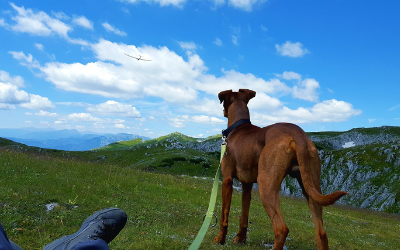
Summer is fast approaching, and holiday plans are being made! With the first long-weekend launching the “unofficial start” of summer, the holidays may be already beginning for some!
Travelling with your pet can be a great experience – long hikes in the woods, swimming at the beach, and camping in the wilderness. There are a few important things to consider before heading out on a trip with your dog (or cat).
Restraints. While traveling in your vehicle, be sure to properly restrain your pet with a pet seat belt or harness, or in a car carrier or crate. If using a carrier or crate, be sure to restrain it. Leash your pet before stopping for an exercise break – your pet may dash out the door as soon as the door opens.
Identification. Make sure you pet is adequately identified before you head out on holidays. Microchipping is a permanent way to identify your pet. Be sure that the contact information associated with the microchip is up-to-date. Purchase an ID collar with your cell phone number on it. Nothing will spoil your vacation faster than a lost pet.
Veterinary Care. Before you hit the road, make sure you know of veterinary hospitals close to your destination. In an emergency, you don’t want to be wasting time searching your phone for a hospital.
Pet First Aid Training. If you plan on camping or hiking with your dog in remote areas, consider taking a pet first aid course. Some organizations offer wilderness pet first aid training for those who will venture into remote areas without easily accessible veterinary care. Be sure to carry a pet first aid kit.
Hot Cars. One of the most common causes of death due to heat exhaustion in dogs is being left in a car. Leaving your dog in the car for a “quick stop” is unsafe. If you plan on visiting museums, zoos, galleries, and other areas where pets aren’t welcome, do not leave your pet in the car. Instead, leave him in your pet-friendly hotel room. Be sure to check with the front desk, however, about rules for leaving your pet unattended in the room.
Hikes. Hiking is a great way to get exercise for both you and your dog! If hiking is on your must-do list, build your dog’s stamina before you head out. After spending the winter walking to the yard and back, taking your dog on a 10km hike will be difficult (for both of you!). Be sure to take frequent breaks for rest and water. Pack a collapsible water dish for your dog and plenty of water for both of you. If hiking at high altitudes, in the mountains, provide your dog with water breaks every 20-30 minutes.
Paws and Pads. If hiking in the mountains, be aware of the terrain. Jagged rocks can damage your dog’s pads, so avoid these hikes altogether. Protect your dog’s feet with hiking boots if he’ll wear them.
Swimming. Allowing your dog to take a dip is a great way for him to get some exercise and cool off on a hot summer day. Check the water though, for hazards, before you let your dog in. Hazards can include blue-green algae (which can cause your dog to become sick), fast moving currents, debris, and rocks. Do not force your dog to swim, and never leave your dog unsupervised – some dogs don’t like water and don’t have the natural instinct to do the doggie-paddle. Rinse your dog off at the end of the day to remove any algae, salts, chlorine, or other contaminants that could irritate your dog’s skin.
Family vacations are all about having fun and making memories! With some planning and preparation, you will enjoy your summer holidays with your pet!